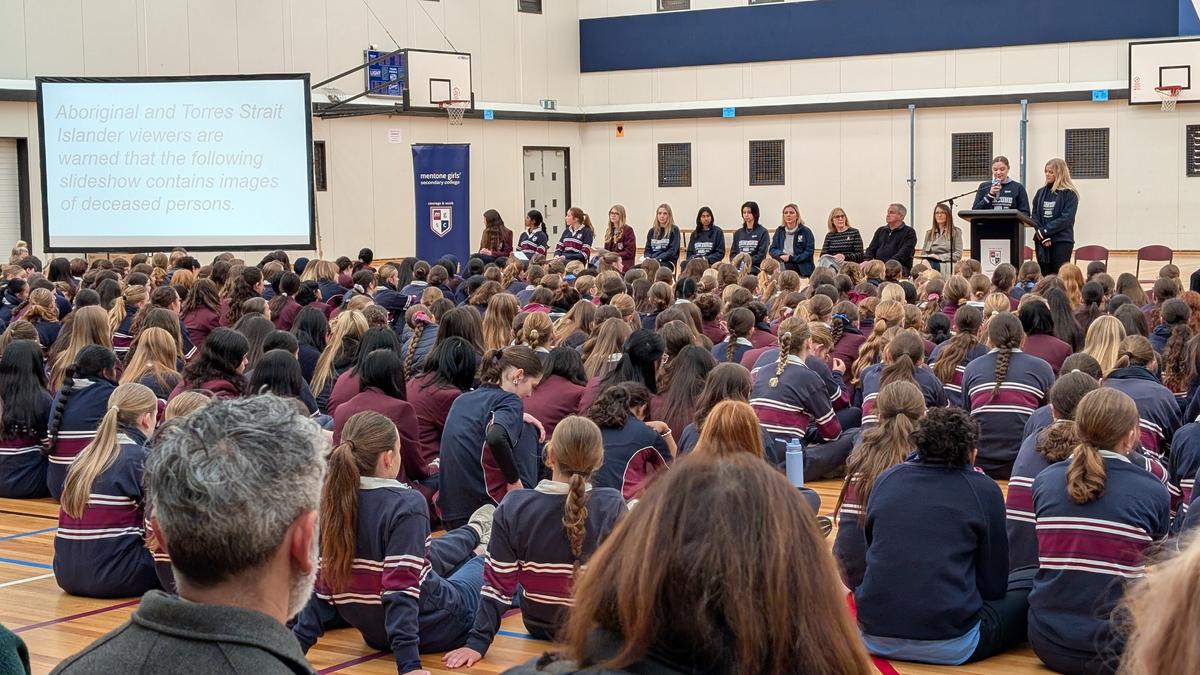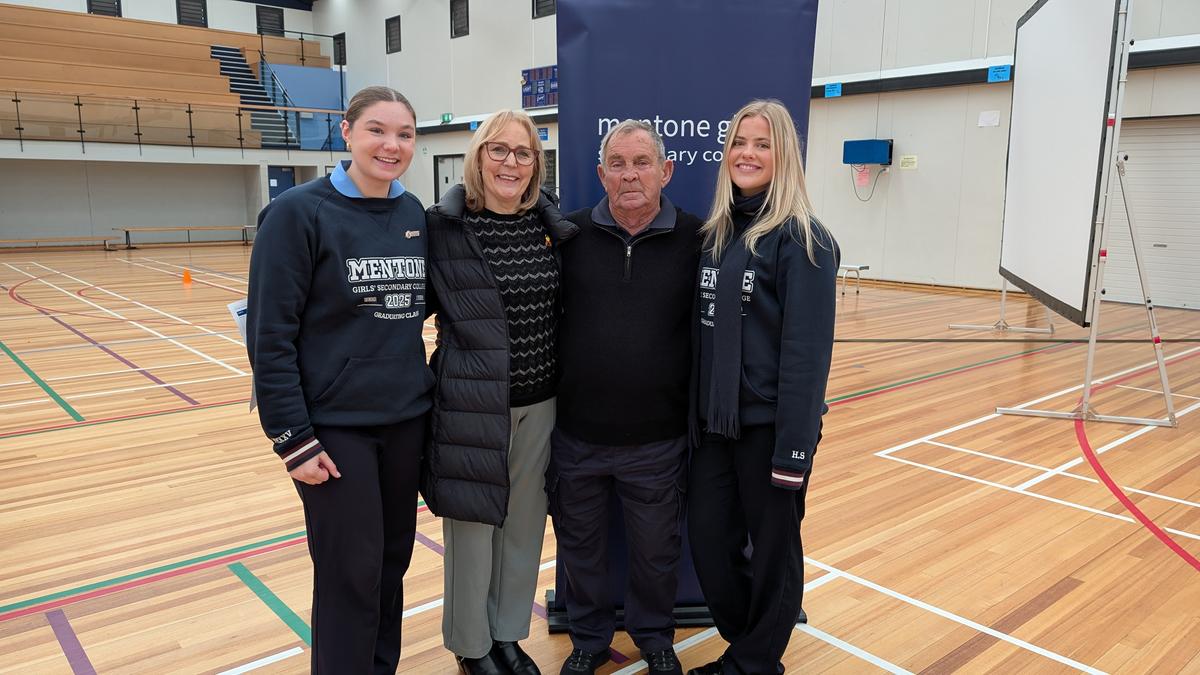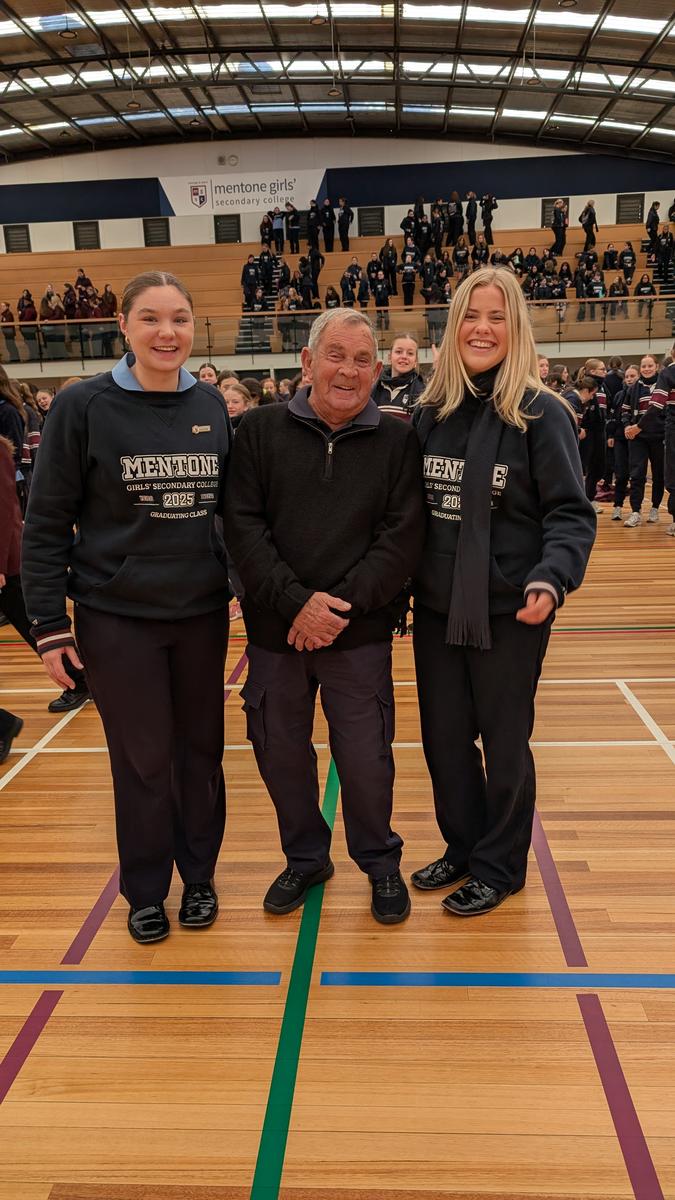NAIDOC Assembly

The final College Assembly for Term 2 focused on NAIDOC. The guest of honour was our very own crossing supervisor, Des Chatfield. This is Uncle Des' and his family's story, as told by College Captains, Matilda Waugh and Harper Shepherd.
NAIDOC stands for National Aboriginal and Islanders Day Observance Committee, which refers to a committee which formed to protest Australia Day and later evolved into a week of nationwide celebrations. The annual NAIDOC week celebration recognises and celebrates the history, culture, and achievements of Aboriginal and Torres Strait Islander peoples
Today, Harper and I would like to speak to you about two significant first nations people we have learned about in the past few weeks.
Part of our preparation for today’s assembly has been to learn more about the history and culture of Aboriginal and Torres Strait Islander people. You may or may not be aware that it is culturally sensitive to let any Aboriginal and Torres Strait Islander people know in advance if you are going to show images of indigenous Australians who have passed away.
In many Aboriginal and Torres Strait Islander cultures, there are cultural protocols around death and the representation of people who have passed away. These customs vary between communities, but a commonly observed practice is to avoid using the names or images of deceased individuals for a period of time following their passing. A warning, often called a "cultural warning", is given before showing photos, videos, or mentioning the names of first nations people who have died, out of respect for the deceased.
This practice reflects the deep cultural importance of mourning and spiritual connection to the deceased in many Indigenous Australian cultures. It is a form of cultural safety and respect. Not all First Nations people follow this custom, but it is widely observed, especially in Northern and Central Australia.
For this reason, we want to let any Aboriginal and Torres Strait Islander peoples joining us here today know that this presentation contains images and names of people who have passed away.
We’d like to tell you about a man named William Wallace Chatfield. This is William Wallace Chatfield shown here, second from the left, on his wedding day in 1920. His wife is Mary Jane Cain.
Several years before this photo was taken, at the outbreak of World War I, William Chatfield had attempted to enlist in the army. In 1918, William enlisted at the Mudgee Recruiting Officer but was assessed at the medical board at Victoria Barracks as being “Unfit for Active Service, Unsuitable Physique (Colour)”.
William was determined to enlist, and he travelled to Coonabarabran in June of 1918 to try once more.
In October 1918 he was finally “taken on strength” of the 1st Light Horse regiment in Egypt.
William Chatfield was one of six First Nations men from the Coonabarabran district who joined the Australian Light Horse and fought in World War I. They fought with pride and conviction for a cause their country believed in. However, the freedoms for which they had fought under the banner of King, Country and Empire were to elude them when they returned to Australia.
When they returned from war, the basic human rights and freedoms which they, as troopers of the Australian Light Horse, had encountered and enjoyed in foreign countries were as far away from Coonabarabran as was the Middle East.
William Chatfield’s son, Jack, later said "Back at home those Aboriginal men were not even allowed in the pubs".
Like most first nations people of that period, the returned soldiers had to have a Certificate of Exemption to enable them to come and go from the missions and reserves they lived on.
These certificates were sometimes referred to as "dog licences" or "beer tickets" which granted certain freedoms and access to services that White Australians had, but at the same time also required individuals to give up their Aboriginal identity and ties to their community in many cases.
This was due to a law called the Aboriginal Protection Act 1869 (Victoria) which was essentially a comprehensive scheme to totally regulate the lives of indigenous Australian people. The powers in this Act meant that the government could control where Indigenous Australian people could live, where they could work, the distribution of their earnings, what kinds of jobs they could do, who they could associate with and who they could marry. It wasn’t until the 1967 referendum, which saw a strong "yes" vote, which marked a turning point in Aboriginal affairs which led to the gradual phasing out of state-based exemption policies.
William's son, Jack, later said about his dad, that "They had fought with pride and conviction for a cause their country believed in. But they had fought for nothing — they weren't even citizens in their own country."
After fighting in the war, William returned to the Coonabarabran district.
William Chatfield married Mary and got a job on the old mission at Burra-Bee-Dee. Recalling family life on the settlement, Jack Chatfield said of his father, "that He raised 11 of us kids on eight bob a day, working on that reserve."
In 1988, 37 years ago, Jack Chatfield said, "Maybe time eventually does change some of the things we strive for. The government tickets are no longer required. Opportunities are being offered to Aboriginals and social attitudes are changing."
Ok. We are going to pause our story there for a moment.
We’d like to tell you about another incredible First Nations person who we have learned more about. His name is Des Chatfield. Des Chatfield was born in September 1945. That means he turns 80 years old this year. Des’ mother, Mavis Chatfield, was the daughter of a man named William Wallace Chatfield. She had 13 children, and Des was the eldest. Des was born in a place called Coonabarabran.
We know that many of you have learned about the Stolen Generation in class. The Stolen Generation refers to a very dark part of Australia’s history, when Aboriginal children were forcibly removed from their families and communities under government policies.
Between 1910 and 1970 thousands of Aboriginal and Torres Strait Islander children were forcibly removed from their families and communities by churches, welfare organisations and governments. The exact number is not known; however, it is estimated that between 20,000 and 100,000 Aboriginal and Torres Strait Islander children were removed from their families and fostered or adopted by non-Indigenous families or raised in institutions against their will. These children were often forbidden from speaking their language or practising their culture, and many suffered abuse, neglect, and loss of identity.
Many of these children experienced neglect, abuse, and exploitative labour, and were denied contact with their birth families. The impacts of these policies created significant intergenerational grief and trauma and continue to be felt by survivors and their families today.
Mavis Chatfield’s son, Des, was taken from her when he was three years old. He was taken to a boy’s home, and while he was there, he didn’t have a name. He was referred to by a number, which was literally written on his arm.
When Des was five years old, in 1950, his mother’s father, his grandfather, William Wallace Chatfield, rescued him from the boy's home he had been taken to. Willam raised and cared for Des until he died in 1953.
Des’s story is one of incredible strength and resilience. He moved to Rockhampton in Queensland when he was 12 years old and worked in sugar cane plantations. He moved to Western Australia where he drove cattle, and then to Sydney where he was a jockey for a short period of time. He then moved to Melbourne, which is where he met his wife, Zena. Zena went to high school here at Mentone Girls’. They married when Des was 21 years old and they had four children.
Like his grandfather, Des is passionate about serving and protecting his community, and while he does it, he brings a smile to the face of many of us each day on our way to and from school. In 2024, Des became unwell and he wasn’t able to work for over six months. While Des was away, some of us wrote messages of well-wishes and these were made into a book, which was delivered to his home. Des was determined to return to work. We were so excited to see Des return to work this term.
We recently reached out to Aunty Katrina Amon, who visited MGSC last year. Aunty Katrina is a significant member of the community and is a great friend of Des and his family.
She has known Uncle Des for a very long time, and has had the pleasure of teaching two of his children, Tammy and Bradley. She shared that Uncle Des has always been community minded. Aunty Katrina knew, when they set up the Derrimut Weelam Gathering Place, that they needed First Nation Elders to come on the board and guide the project. Uncle Des was quick to say he would be involved and his input and the time he contributed has made the Gathering Place the successful community hub it is today.
St Kilda Football club have a First Nations and Multicultural Academy. Young footballers who have a dream of playing AFL and AFLW. Uncle Des is an ambassador for the program and loves having a yarn with the young kids.
Aunty Katrina shared that Uncle Des is a very thoughtful man, and is always thinking of others. Last week he called her just to see how she was travelling. Aunty Katrina knows that if she ever needed anything or support, she could count on him in a heartbeat. She says, “That is who he is, always there for you”.
Sometimes, when you hear about things that have happened in the past, such as the stolen generation, they seem quite removed from our day-to-day lives. While we always knew that Des was a very special member of our community, we have now learned more about his incredible life and the achievements of his grandfather, William Chatfield. Today, we celebrate Des returning to work and we also recognise a significant indigenous Australian figure in our community, Uncle Des. Uncle Des has been heavily involved with the Derrimut Weelam Gathering Place in Mordialloc. He is a survivor of the stolen generation and the grandson of a celebrated war hero.
We would now like to play this video to show our thanks to Des for keeping us safe in our school community.



